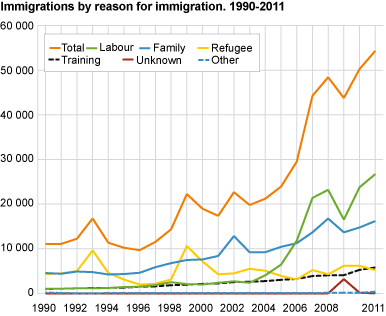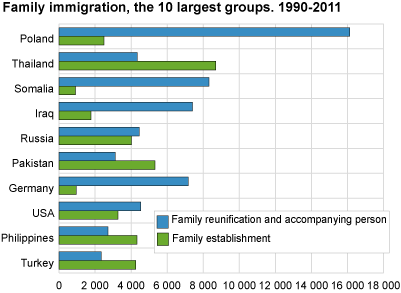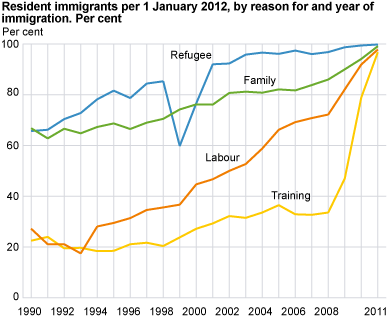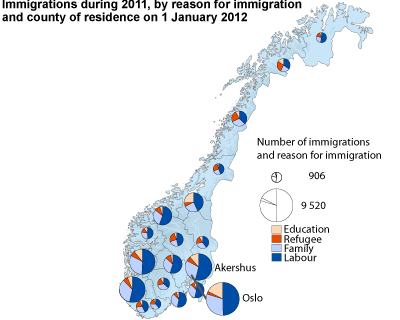Content
Published:
This is an archived release.
Labour immigration hits record high
Immigration to Norway in 2011 was the highest ever recorded. A total of 54 300 persons with non-Nordic citizenship immigrated. Almost half of these; 26 700 persons, were labour immigrants. Compared with 2010, 1 000 fewer persons came to Norway due to flight.
No information is available concerning reason for immigration for citizens of Nordic countries because they do not need to apply for a residence permit or register at a police station.
Most from Poland and Lithuania
Immigrants from Poland made up the largest group in 2011, with 11 700 persons. Lithuanian citizens followed next with 7 400. Eight out of ten of these came to Norway as labour immigrants. These two groups were by far the largest and there is a major leap to the next groups; Filipino, German, Latvian and Eritrean citizens with around 2 000 persons each. Sixty per cent of the Filipino citizens received permission for education. From Eritrea, the majority arrived as asylum seekers, and the rest were family migrants.
Growth in number of labour immigrants
In 2011 there were 26 700 persons from non-Nordic countries that immigrated due to labour; the highest number ever registered. Seven out of ten of these came from the new EU countries in Eastern Europe.
Out of those who came to Norway in 2011 due to labour, immigrants from Poland made up the largest group with 9 100. Labour migration from Lithuania has also been significant, with a total of 5 600 new immigrants last year.
16 000 came for family reasons
During 2011, 16 200 immigrants came to Norway for family reasons. The largest groups of family immigrants were Polish (2 500) and Lithuanians (1 700), followed by persons from Thailand (1 100) and Philippines (700).
Family immigration includes persons who immigrate through family reunification and those who immigrate through family establishment. Out of the 16 200 persons who came to Norway due to family reasons, 12 100 came as family reunified and 4 100 immigrated for family establishment through marriage.
More people immigrate for education
The number of persons who immigrated for education has risen significantly in the last two years. A total of 5 800 persons immigrated in 2011 due to education. This was an increase of 500 since 2010, and the highest number ever registered. There were relatively many immigrants from the Philippines (1 500), China (400) and Germany (300) in this group. The number of registered students from the Philippines is high because the au pair permit is also considered to be a type of education permission.
Fewer immigrate due to flight
Compared with 2010, 1 000 fewer persons came to Norway due to flight, a total of 5 200 persons. Most of them came from Eritrea, Somalia and Afghanistan, and they made up only 10 per cent of the non-Nordic immigrants in 2011.
High proportion of residents
A total of 525 000 persons with non-Nordic citizenship immigrated to Norway between 1990 and 2011 and 75 per cent still lived in the country at the start of 2012. The reason for immigration has a bearing on the degree to which they leave the country. Of those who immigrated due to flight, 84 per cent still lived in the country by 1 January 2012. Also among family immigrants, there are many who still live in Norway; 81 per cent.
The corresponding percentage for those who immigrated for education was 42 per cent. A residence permit for students does not entitle them to a permanent residence permit. The intention is that foreign students return home after finishing their education in Norway.
There has been public interest in the settlement pattern of the labour migrants from the new EU countries in Eastern Europe. Among those who immigrated in 2005, immediately following the expansion of the EU, 66 per cent were still resident in Norway on 1 January 2012. As many as 98 per cent of labour immigrants who settled in Norway in 2011 still lived in the country at the beginning of 2012.
|
Statistics on reason for immigration include all immigrants with non-Nordic citizenship that immigrated to Norway between 1990 and 2010. Employees on short-term stays (less than six months) are not registered as residents in the population register and thus not included in the statistics. Persons adopted from abroad are not included in the statistics because they are not considered to be immigrants. The most important data sources are the Directorate of Taxes’ Central Population Register (CPR) and the Norwegian Directorate of Immigration’s Aliens Register (UDB). |
Tables:
- Table 1 Immigrations, by reason for immigration, year of immigration and citizenship. 1990-2011
- Table 2 Immigrations, by reason for immigration and citizenship. 1990-2011
- Table 3 Immigrations, by reason for immigration and citizenship. 2011
- Table 4 Immigrations, by reason for immigration, year of immigration and immigrants still resident on 1 January 2012. 1990-2011. Absolute numbers and per cent.
- Table 5 Immigrants with family as reason for immigration, by type of family unification, immigrant category of reference person and citizenship. 2011 and 1990-2011
- Table 6 Family immigrations , by type of family unification, immigration category of reference person, year of immigration and first citizenship. 2011
- Table 7 Immigrations, by reason for immigration, sex and age. 1990-2011
- Table 8 Immigrations, by reason for immigration and county/municipality of residence on 1 January 2012
- Table 9 Immigrations during 2011 by reason for immigration and county of residence on 1 January 2012
Contact
-
Statistics Norway's Information Centre
E-mail: informasjon@ssb.no
tel.: (+47) 21 09 46 42
-
Oppdrag innvandring
E-mail: oppdraginnvandring@ssb.no
-
Mads Ivar Kirkeberg
E-mail: mads.ivar.kirkeberg@ssb.no
tel.: (+47) 40 81 13 21
-
Frøydis Strøm
E-mail: froydis.strom@ssb.no
tel.: (+47) 40 81 13 17




